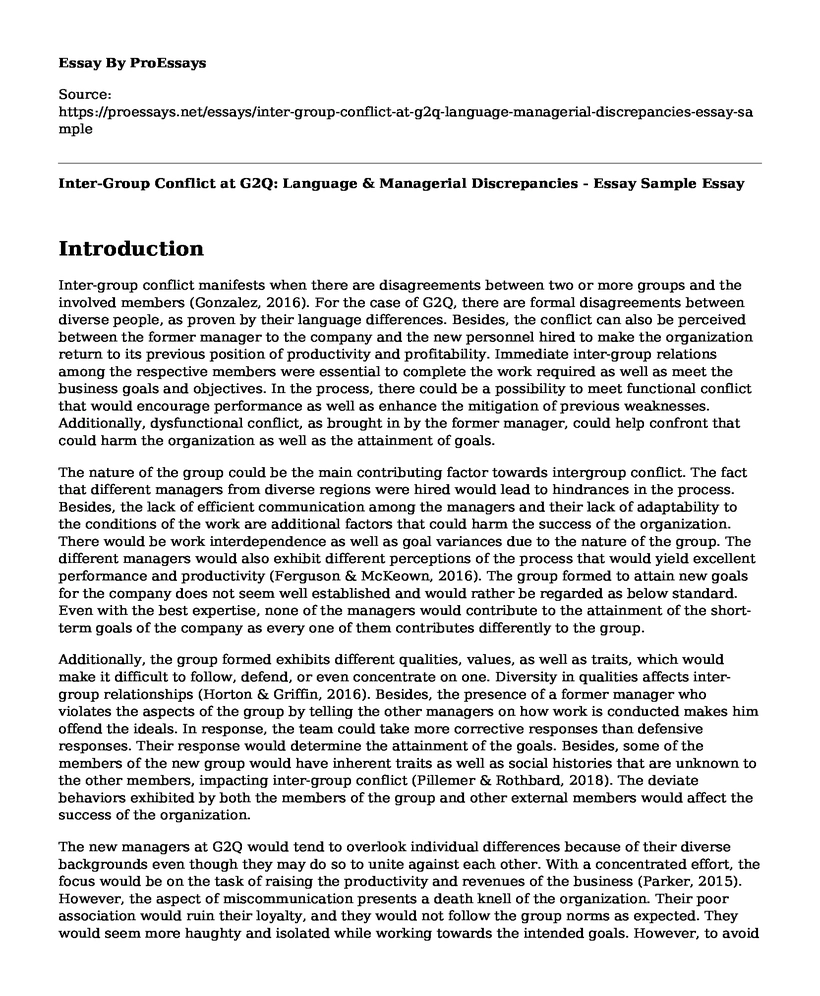Introduction
Inter-group conflict manifests when there are disagreements between two or more groups and the involved members (Gonzalez, 2016). For the case of G2Q, there are formal disagreements between diverse people, as proven by their language differences. Besides, the conflict can also be perceived between the former manager to the company and the new personnel hired to make the organization return to its previous position of productivity and profitability. Immediate inter-group relations among the respective members were essential to complete the work required as well as meet the business goals and objectives. In the process, there could be a possibility to meet functional conflict that would encourage performance as well as enhance the mitigation of previous weaknesses. Additionally, dysfunctional conflict, as brought in by the former manager, could help confront that could harm the organization as well as the attainment of goals.
The nature of the group could be the main contributing factor towards intergroup conflict. The fact that different managers from diverse regions were hired would lead to hindrances in the process. Besides, the lack of efficient communication among the managers and their lack of adaptability to the conditions of the work are additional factors that could harm the success of the organization. There would be work interdependence as well as goal variances due to the nature of the group. The different managers would also exhibit different perceptions of the process that would yield excellent performance and productivity (Ferguson & McKeown, 2016). The group formed to attain new goals for the company does not seem well established and would rather be regarded as below standard. Even with the best expertise, none of the managers would contribute to the attainment of the short-term goals of the company as every one of them contributes differently to the group.
Additionally, the group formed exhibits different qualities, values, as well as traits, which would make it difficult to follow, defend, or even concentrate on one. Diversity in qualities affects inter-group relationships (Horton & Griffin, 2016). Besides, the presence of a former manager who violates the aspects of the group by telling the other managers on how work is conducted makes him offend the ideals. In response, the team could take more corrective responses than defensive responses. Their response would determine the attainment of the goals. Besides, some of the members of the new group would have inherent traits as well as social histories that are unknown to the other members, impacting inter-group conflict (Pillemer & Rothbard, 2018). The deviate behaviors exhibited by both the members of the group and other external members would affect the success of the organization.
The new managers at G2Q would tend to overlook individual differences because of their diverse backgrounds even though they may do so to unite against each other. With a concentrated effort, the focus would be on the task of raising the productivity and revenues of the business (Parker, 2015). However, the aspect of miscommunication presents a death knell of the organization. Their poor association would ruin their loyalty, and they would not follow the group norms as expected. They would seem more haughty and isolated while working towards the intended goals. However, to avoid the conflicts that would affect group performance, the CEO would consider focusing more on problem-solving, encouraging simple avoidance of petty issues within the company such as overlooking others' qualities, and changing various variables such as communication methods within the organization. For instance, the CEO would organize a face-to-face meeting to address any misunderstanding and language barriers within the organization.
References
Ferguson, N., & McKeown, S. (2016). Social Identity Theory and Intergroup Conflict in Northern Ireland. Understanding Peace and Conflict Through Social Identity Theory, 215-227. doi:10.1007/978-3-319-29869-6_14
Gonzalez, J. A. (2016). Demographic Dissimilarity, Value Congruence, and Workplace Attachment. Journal of Managerial Psychology, 31(1), 169-185. doi:10.1108/jmp-07-2013-0256
Horton, K. E., & Griffin, M. A. (2016). Identification Complexity and Conflict: How Multiple Identifications Affect Conflict across Functional Boundaries. European Journal of Work and Organizational Psychology, 26(2), 286-298. doi:10.1080/1359432x.2016.1259215
Parker, C. (2015). Practicing Conflict Resolution and Cultural Responsiveness within Interdisciplinary Contexts: A Study of Community Service Practitioners. Conflict Resolution Quarterly, 32(3), 325-357. doi:10.1002/crq.21115
Pillemer, J., & Rothbard, N. P. (2018). Friends Without Benefits: Understanding the Dark Sides of Workplace Friendship. Academy of Management Review. doi:10.5465/amr.2016.0309
Cite this page
Inter-Group Conflict at G2Q: Language & Managerial Discrepancies - Essay Sample. (2023, May 02). Retrieved from https://proessays.net/essays/inter-group-conflict-at-g2q-language-managerial-discrepancies-essay-sample
If you are the original author of this essay and no longer wish to have it published on the ProEssays website, please click below to request its removal:
- Describe a Compensation Strategy for an Organization Paper Example
- Management Decision Problem for Increasing Share of the Athletic Shoe Market
- Proposed Advancement to the Crane Manufacturing System for Megacorps CMC
- The Jacobs' Family Values Essay Example
- Essay Example on Product Liability & Baby Products: Safety First!
- Paper Example on Strategic Control for Successful Implementation of Strategic Plan
- Lesson Learned: Most Valuable for Future Performance - Paper Sample







